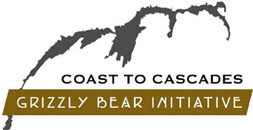We are often asked why we have chosen to focus our efforts on grizzly bears, as opposed to caribou, lynx, wolverines, wolves or many of the other species currently under threat in the Coast and Cascade Ranges. This years World Wildlife Fund Living Planet Index report highlighted that globally populations of mammals, birds, reptiles, amphibians and fish have declined by an average 52% in the last 40 years. Global populations of freshwater species have suffered an even worse fall of 76%. So why grizzlies?
First Nations and scientists have long recognised that grizzly bears are barometers of wilderness and the health of ecosystems. They require large tracts of wild habitat with rich, diverse and seasonal foods like berries, roots and salmon. When grizzly bears are present, we know that these same healthy wild landscapes also provide our society clean water, robust forests and diverse wildlife. Coast to Cascades grizzly bears are an early warning system indicating how well we are stewarding natural systems for future generations.
Creative Director - Aaron Straight | Editor - Miles Lippold |Co-writters - Chris Morgan & Aaron Straight Music - David Schommer | Illustrations - Paul du Coudray | www.whybears.org "What if we could preserve wild spaces simply by protecting one family of animals?" This film is for teachers, scientists, non-profits and people interested in bears and preserving wild spaces. This film was made possible by an anonymous donation and was produced in partnership with Wildlife Media. What's good for bears is good for people and the planet. www.whybears.org
